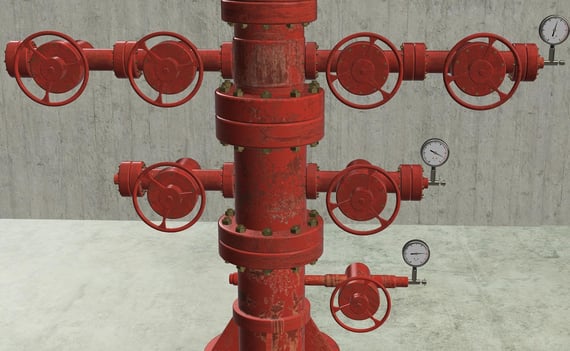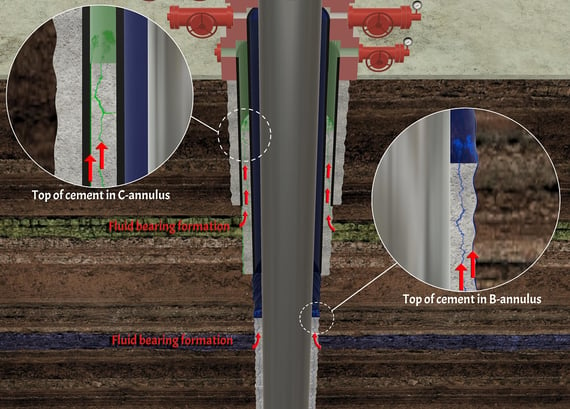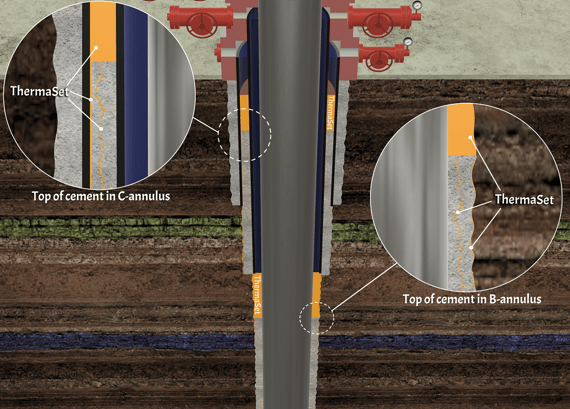Sustained Casing Pressure CCA
Intro: Sustained Casing Pressure
Many oil and gas wells develop leaks in the annulus, either it is A, B, C or D annulus. This issue has several names:
- SCP (Sustained Casing Pressure)
- SAP (Sustained Annulus Pressure)
- CCA (Casing-Casing Annulus)
Regardless of definition, we are talking about a well integrity issue with a failed barrier.
Case Study: Sustained Casing Pressure in the Dutch Sector of The North Sea
Wellcem have performed several successful jobs
Why SCP may be a challenge
To have some pressure on one of the annuli, either B, C or sometimes even further out, isn’t very unusual, and honestly - in many cases not a serious problem, more of an irritation that must be managed.
The pressure must be monitored, maybe it must be bled off periodically, some reports must be made, some risk assessments and possibly permissions to keep it like this, because really you have one barrier in your well that has been breached.
At some stage, this barrier needs to be reinstated. Then you have the annulus that has higher and more aggressive pressure, in some cases you may have to shut on the well. It is a much more serious issue then and of course, if you are unable to produce the well, an expensive one as well.
From the Well Integrity Blog: This is how we dealt with sustained casing pressure
What are the options?
The options are just managing the leak, as described above, or a total workover.
Workover
A total workover of the well is sometimes done, normally not only because of a small leak in the annulus. But if a work-over is needed because of other reasons, the leak in the annulus may also be possible to rectify the same time.
A-annulus leaks (annulus between production tubing and the last casing or liner) can be complex and can have a number of causes, they are not always easy to fix. But leaks in B, C and D annulus are very good candidates for the Wellcem technology.
Related blog post: Sustained casing pressure (SCP): When do we have a problem?
Before completion.jpg?width=570&name=SCP%20before%20completion%20(1).jpg)
If you have not yet completed the well or you are going to permanently abandon it, the situation is a bit different. In those cases, you can very often remedy the leak at or near its source via a work string down the well.
Wellcem can also do those type of jobs, and believe we are much more likely to make a successful squeeze into an annulus where you access it through perforations or a milled section than for example by using cement.
But when you have the well in production or it has already been completed and it starts developing a leak coming up the annulus, a solution is not that straight forward.
Related blog post: How to seal a leak you cannot get to?
How to solve SCP (SAP/CCA) with resins
Many wells are more complicated to seal, but most are possible to seal. The biggest problem are wells where little is known, the top of cement in the annulus is unknown, what fluids or if any on top of the cement is unknown, leak rate (or injectivity is unknown).
It is important and not that hard to establish these parameters, but they do require some planning. The hardest on old wells are often to find out what fluids are in the annulus. Even if you bleed off gas, or liquid hydrocarbons or water, it isn’t guaranteed that the rest of the annulus is filled with the same fluid.
Some assumptions can be made, and some range of parameters can be accepted and taken into account when designing and planning a job. But the more accurate information that exist, the easier it is to design a successful remedial job.
Download Free Guide: The most common causes for leaks in oil wells, and 8 questions to consider before selecting a solution
By using our resin-based ThermaSet solution, Wellcem has sealed up annular leaks through many hundred meters of various fluids in the annulus. No work-over, no rig or pulling of completion is required and it is a rather simple operation with little equipment needed.
For simple land wells with cement to surface, we will pump and squeeze ThermaSet into the annulus and down the leak path. Just a very small volume can reach very far into a narrow leak path. It reaches far because of very low viscosity and that it is solids-free. The carefully timed setting ensures optimum penetration and placement before the resin cures up and ensures the leak is permanently sealed.
From the Well Integrity Blog: The resin curing process
 |
 |
| SCP in B- & C- annuli due to cement failure | Principle of eliminating SCP in B- & C- annuli using ThermaSet resin |
If you want to get more insight to resin-based solutions like ThermaSet for Sustained Casing Pressure (SCP), click here:
SCP Case Studies
Sustained Casing Pressure: Dutch Sector of The North Sea
SCP Articles in The Wellcem Well Integrity Blog
- Sustained Casing Pressure (SCP): Defining if a scenario needs intervention.
- Sustained casing pressure (SCP): When do we have a problem?
- This is how we dealt with sustained casing pressure.
- How to seal a leak you cannot get to?
You may also want to learn more about other areas of application like Casing Leak and more, just scroll down -->
Applications for the Wellcem solution
Application
Plug & Abandonment
The primary objective is to ensure that no leaks to surface exist and that no formation fluid migration occurs even many years after the well has been abandoned.
Application
Zonal Isolation
Most oil and gas wells have different zones. Zonal isolation seeks to segregate undesirable intervals from production.
Application
Sustained Casing Pressure
Regardless of definition, either SCP, SAP or CCA, it is a well integrity issue with a failed barrier. It requires management or workover.
Application
Casing Leak
Casing leaks are often a result of leaking casing threads, burst casing from pressure, corrosion or from casing wear due to extended periods of drilling operations.
Application
Lost Circulation
Lost Circulation means you are losing your circulation of fluids off to a low-pressure and permeable formation somewhere in the well.
Application
Control Line
Many wells have a hydraulic control line running down along the casing or tubing. Control lines can develop an undesired leak.




